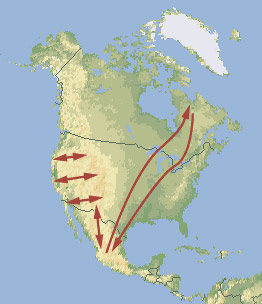 |
 |
 |
 Travel & Outdoors | July 2005 Travel & Outdoors | July 2005  
Migration of the Monarchs
 LiveMonarch.com LiveMonarch.com



 | | During the summer months, Monarchs can be found throughout the continental United States and parts of Canada, and they migrate to the California coast and central Mexico for the winter. The longest recorded flight for a tagged adult is 2,900 km (1,800 mi). A large number of Monarchs spend their winters in the mountains west of Mexico City. |
Danaus Plexippus is the scientific name for the Monarch Butterfly. Monarchs can be found on all continents wherever milkweed plants are except the polar regions. Eastern Monarchs spend their winter high in the Mountains located west of Mexico City. Western Monarchs are found from the Rockies to the Pacific Ocean and spend the winter months in several areas along the coast of southern California. With a wingspan up to 4 3/4 inches, Monarch butterflies are among the largest and most beautiful butterflies in North America.

The Monarch is one of the longest migrating creatures on Earth. Beginning in August, millions of Eastern Monarchs (those living from the Rockies to the Atlantic Ocean) migrate from their summer feeding and mating grounds to Mexico, where they spend the winter before returning to the United States in late February and March to begin the cycle of life again. Monarchs live in all states and reproduce wherever they can find enough Milkweed to support their young. Monarchs are not pests and will not eat anything but Milkweed. They do not hurt crops, ornamental trees or in any way upset the balance of Nature in areas they are introduced. Monarchs are the State Butterfly of Alabama, Idaho, Illinois, Texas, West Virginia and Minnesota.

The life span of an adult Monarch is normally 4 to 8 weeks, except for those that enter diapause (delayed sexual maturity) and migrate to Mexico to spend their winter vacation. Those individuals can live up to 8 or 9 months.

Monarchs are not as plentiful as they were years ago, the use of insecticides and herbicides has eliminated much of their habitat. The milkweed that, the Monarch depends upon for survival, is disappearing as meadows and prairie are developed. While the winter population in Mexico numbers 200 to 400 million, many feel the Monarch may not survive. In 1991 about 70% of these wintering Monarchs in Mexico froze to death as a result of three days of rain and sub freezing conditions. This was an enormous tragedy for our friends the Monarch and they have not been seen again in many Nothern regions.

Habitat must be protected now, before we see the day when this miracle of nature is only a memory. We include Milkweed seeds with every order and have Free seeds for you if you send us a self addressed stamped envelope. The Monarchs and many butterfly species need your help. Please plant seeds and ensure their survival. Planting new habitat will not only help butterflies around your home but will help butterflies reach others who without your assistance would not see a Monarch. One seed can change the world, we need you to plant it.

For more information on how you can help to assure the successful migrations of future Monarch Butterflies, visit www.LiveMonarch.com. | 
 | |
 |



